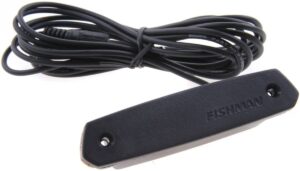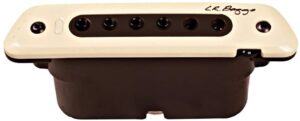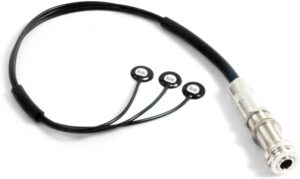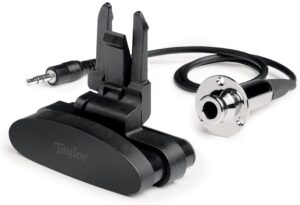What is the best pickup for Taylor GS Mini? We know the right answer.

The smaller version of its universally acclaimed cousin, the Grand Symphonic, the Taylor GS Mini acoustic bass, packs excellent sound in a compact body. Moreover, since the GS Mini’s bodywork is modeled on the Grand Symphonic, the guitar replicates its big brother’s warm tone and bass intensity.
This acoustic guitar comes with ES-Go, a premium magnetic soundhole pickup, so if you’re thinking of replacing/upgrading the stock pickup, you know what to look for.
As the Taylor GS Mini is smaller than standard-size and larger acoustic basses, installing standard aftermarket or third-party pickups on/in the bridge or soundhole is an issue. Therefore, when choosing an appropriate replacement pickup for GS Mini, you need to be quite cautious as you’ve limited options.
The 4 Best Pickups for GS Mini
| Image | Model | Price |
|---|---|---|
 | Fishman Neo-D (Top Pick) | Check Price |
 | L.R. Baggs M80 (Close Runner-Up) | Check Price |
 | K&K Pure Mini | Check Price |
Fishman Neo-D (Editor’s Choice)
The Fishman Neo-D Humbucker Acoustic Pickup is a value-optimized sibling of the coveted Rare Earth pickup sharing the latter’s features. For instance, the Neo-D features the same Neodymium magnet as the Rare Earth, lending the former fantastic string equilibrium and exceptional acoustic lucidity. In addition, the high-impedance and unassuming discreet layout do away with the need to use a battery for taking advantage of Neo-D.
The Neo-D humbucker is a passive acoustic pickup with a compact form factor for allowing players to fit it easily on their flat-top acoustic basses. Like the Rare Earth, the Neo-D features an advanced coil structure and an exclusive layout of Neodymium magnets, making this pickup ideal for acoustic bass guitars. The Neo-D humbucker works best on acoustic guitars integrated with stainless steel-, phosphor bronze- or bronze strings.
The Fishman’s Neo-D humbucker, which has been around for many years, is also available as a single-coil version. The dimensions of the humbucker Neo-D are the same as the single-coil though humbucking pickup uses a stacked coil. In addition, the humbucker comes with a 9-foot long cable and a standard ¼-inch plug, which facilitates an easy plug-and-play application.
Consummate bassists will feel the balanced output with a pronounced smooth and warm attack and sparkling high-end clarity. The bottom-end is richer and smoother, while the overall sound is not very trebly and noticeably less grimy than a single coil.
Installing the Fishman Neo-D humbucker pickup for an acoustic guitar should not be a problem as the pup easily fits across soundholes with a diameter as low as 98.4mm (3-7/8″). This hum-bucking pickup also comes equipped with a prewired output jack (that can be endpin mounted as well) which relieves you from soldering hassles.
Pros
- It doesn’t require any battery for performing thanks to its high-impedance and low-profile design
- It comes with stacked coils for eliminating hum and feedback
- Outstanding tonal balance across the strings resulting in excellent acoustic clarity
- Simple mounting: No need to undertake any modification in your instrument for fitting the pickup, just plug-and-play
- Includes Neodymium magnet that guarantees bright acoustic notes and superlative string-to-string balance
- Not only pickups the vibrations from the strings but also brings out your instrument’s character
Cons
- You’ll need to position the pickup right at the top of the soundhole as the pup is a tad too narrow for the soundhole
- The jack cable is way too long
- The sound is somewhat low
L.R Baggs M80
If the tonewood of your acoustic bass guitar is the instrument’s soul, then the rest of the components comprise the bass’s niceties. Most of the magnetic soundhole acoustic bass pickups out there just pickup dry string vibrations unable to capture the natural voice of your acoustic guitar. However, the M80 magnetic soundhole pickup is supremely capable of heeding the complete frequency range vibrated and reproduced by the tonewoods.
As a result, bassists get to hear sounds that are intensely warm, vivid, rich, and complex. At the heart of the M80 lies a patented, free-floating humbucking coil which functions very much like a 3D body sensor. An exclusive suspension enables all the axes of the humbucking coil to respond effectively with every tonewoods vibration.
The resonation of the soundboard in all three dimensions leads to the generation of a body signal that combines with the strings’ vibration, ultimately letting your instrument portray its intrinsic sound character. In addition, the L.R. Baggs M80 acoustic guitar magnetic soundhole pickup comes with an intuitive switch that you need to flip for choosing active or passive settings. Switching to “active” causes the activation of a preamp featuring integrated EQ and audiophile circuitry for delivering “high-fidelity” sonic.
On the other hand, when you flick the switch to passive mode, you bypass or do away with the preamp for a battery-free operation. The M80 magnetic soundhole pickup is immensely successful in perfectly blending the character of your instrument’s tonewoods and strings. As a result, your instrument’s natural and authentic acoustic voice is fully brought out when you take the stage for performing live.
On the one hand, the M80 exposes and depicts your acoustic bass guitar’s intrinsic sonic persona. On the other lets, you’ve thorough control over your sound owing to the incorporated volume control. Furthermore, L.R. Baggs’ M80 includes a removable cable prewired to an endpin jack that straightaway plugs into the pickup through a 1/8″ TRS plug, thus rendering installation a breeze. Overall, the sound of M80 embodies the best elements of a soundboard transducer and a magnetic pickup, thereby lending an inimitable flavor to your sound.
Pros
- Acoustic guitar magnetic soundhole pickup capable of perceiving the full gamut of frequencies, thus enriching the instrument’s amplified sound
- Distinct switch for switching between ‘active’ and ‘passive’ modes
- Effectively captures your acoustic bass guitar’s innate voice
- Immaculate string-to-string balance thanks to adjustable pole pieces, volume control, and battery check features
- Floating secondary coil facilitates the generation of pulsations in the magnetic field, making M80 perform like a mic better capable of broadcasting lower frequencies
- It behaves similar to a dual-source system integrating the best features of a soundboard transducer and a standard magnetic pickup
Cons
- The M80 is overly sensitive to strumming, plucking, or brushing (can be remedied considerably by placing soft pads between the guitar top and the soundhole)
- Installation may be a problem, especially on smaller soundholes
K&K Pure Mini
K&K Sound’s Pure Mini is a versatile 3-in-1transducer system that doesn’t require on-board electronics or batteries for operation. This transducer-only contraption by K&K Sound is in a class of its own as the pickup excels indirectly driving amps and PA systems. The K&K Pure Mini transducer goes a long way to enable your instrument to deliver deep and delicate notes without a preamp.
Owing to Pure Mini’s placement a little farther from the strings than an under-saddle pickup, this surface transducer reproduces a substantial amount of the soundboard’s vibrations. Every one of the three transducers has been designed with meticulous care for equipping them with the capability to pick out the pulsations of a string pair as well as the bridge section’s resonance. You bet that your sound will feel amusing and harmonious as the Pure Mini portrays and exposes your acoustic bass’s soundstage.
This transducer system outperforms piezoelectric/under-saddle pickups when it comes to reproducing the sonic character of each string. The Pure Mini, though a passive transducer, reproduces full-range sound that is also well-balanced and does not sound tinny. Quite significantly, the K&K Pure Mini can thwart feedback and microphonism better than piezoelectric pickups.
K&K Sound’s Pure Mini is very user-friendly and ideal for sculpting your signature sound as a bridge-plate transducer and an acoustic guitar pickup. Overall, the Pure Mini makes your instrument deliver an amazingly organic tone and pure with excellent transparency. Since the Pure Mini is a passive transducer pickup positioning, a DI will be essential for boosting up the signal.
Pros
- Includes a prewired output jack cable with an endpin socket for easy mounting without the hassle of soldering
- Three-transducers-in-one that works exclusively with steel-stringed acoustic bass guitars
- Well-rounded and captivating sound with discernibly warm and mellow tunes that sound perfectly natural
- Performs way better than under-saddle piezoelectric pickups
Cons
- It doesn’t pair with acoustic basses that don’t have stainless steel strings
- Top-end lacks that unmistakable spark, while the midrange is a tad bloated
- There is audible irritating feedback when you increase the volume
Taylor ES Go

The Taylor GS Mini Acoustic Bass Guitar and the ES-Go Magnetic Acoustic Bass Pickup are made for each other. A magnetic soundhole pickup, the ES-Go, has been created by Taylor solely for the GS Mini. At the same time, mounting the ES-Go on the Taylor GS Mini should not be an issue as the pickup includes a prewired output jack cable with an endpin socket.
You need a screwdriver for unscrewing and detaching the existing endpin, screw on the ES-Go’s socket endpin for attaching the pickup to the endpin via a standard jack. Once you’re through with installing the ES-Go, the pickup will help amplify the output of your GS Mini in no time, letting you create your personalized sound.
After fitting the ES-Go in the Taylor GS Mini, plug the acoustic bass connector jack into a PA system or acoustic guitar amp. The ES-Go is a passive acoustic bass magnetic soundhole single-coil pickup featuring a V-cable with integrated volume control. As a humbucking pickup, the ES-Go works wonders when it comes to effectively reproducing the acoustic voice of your instrument.
Simply put, the Taylor’s ES-Go magnetic soundhole pickup transforms the ¾-size GS Mini into an excellent sounding acoustic-electric bass.
Pros
- Designed especially for Taylor GS Mini
- Natural sounding
- Resists feedback effectively
Cons
- Fitting this pickup in the factory fitted bracket is a struggle, unlike what is claimed by the manufacturer
- Many players have complained of an overpowering buzz after connecting the guitar to an acoustic amp.
How Do Acoustic Pickups Work?
Acoustic bass guitars sound great when you play them in private, letting you feel those subtle and understated sonic details. However, when you try to strum, pluck or brush your acoustic bass’s strings during a live show, the sound is barely audible. And this is the most substantial downside of acoustic guitars, which you can effectively fix by mounting or installing pickups.
Though dynamic mics enable you to highlight your instrument’s natural acoustic voice, mics require you to position yourself close to them, thereby restricting movement. And then again, mics are not even half as versatile as magnetic soundhole-, soundboard transducer, piezoelectric (under-saddle) – or internal mic pickups used in acoustic guitars. This guide walks you through the different pickups usually paired with a standard acoustic bass guitar.
Under-Saddle Pickup
As the name specifies, an under-saddle pickup mounts on the underside of your acoustic bass’s saddle. Under-saddle pickups exploit piezoelectric technology where a crystals strip positioned under the guitar’s bridge picks out the pressure waves generated by vibrating strings. Undersaddle pickups, very much like magnetic soundhole pickups, sense just the strings’ throbs but not the body’s.
Nevertheless, an undersaddle pickup sounds brighter and punchier with a beefier attack as it captures the strings ends’ vibrations. However, you’ll need a preamp for enhancing the source signal as undersaddle pickups have a lower voltage than magnetic soundhole pickups.
Magnetic Soundhole Pickup
Most bassists, by and large, fit magnetic soundhole pickups in their instruments, and for good reasons. Magnetic soundhole acoustic bass pickups outshine other acoustic bass pickup types in delivering tunes that nearly replicate electric guitars. A magnetic soundhole pickup creates an external magnetic field for picking up strings’ vibrations and transforms the magnetic energy into sound energy.
Mounting or dismounting magnetic acoustic bass pickups usually is simple for which you don’t have to make alterations to your guitar. Though you may experience a degree of noise or feedback with standard models, the top-notch ones effectively keep microphonism to a minimum.
Internal Mic Pickup
An internal mic pickup implanted inside your bass guitar (the sound chamber) functions more like an ext mic. The best thing about miniature internal mics is that they sound much better than magnetic or undersaddle pickups. But you’ve to put up with some glaring drawbacks when you use an internal mic, including exasperating feedback (due to their extreme sensitivity).
Additionally, internal mic pickups tend to be very costly, not to mention the expenses you’ll have to incur for professional installation, which is essential for a proper fit.
Soundboard Transducers
A soundboard transducer is a variation of the piezoelectric undersaddle pickup, referred to as ‘bottle caps’ or ‘contact pickups. Soundboard transducers perceive vibrations not only from your instrument’s strings but also from the unit’s tonewoods, thereby bringing out the acoustic bass’s natural sound qualities perfectly. You can install soundboard transducer pickups anywhere on your acoustic guitar, which signifies their versatility and flexibility.
However, a soundboard transducer like a mic-style pickup can attract feedback easily.
Conclusion: The Best Replacement Pickup for GS Mini
If you’re serious about getting the best out of your acoustic bass guitar, say a GS Mini, then go for the Fishman Neo D or L.R. Baggs M80 pickups.
The M80 magnetic soundhole pickup has everything going for it, including an active/passive flip switch and a free-floating secondary coil making it the best fit for your instrument.